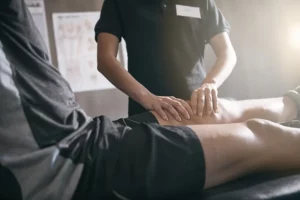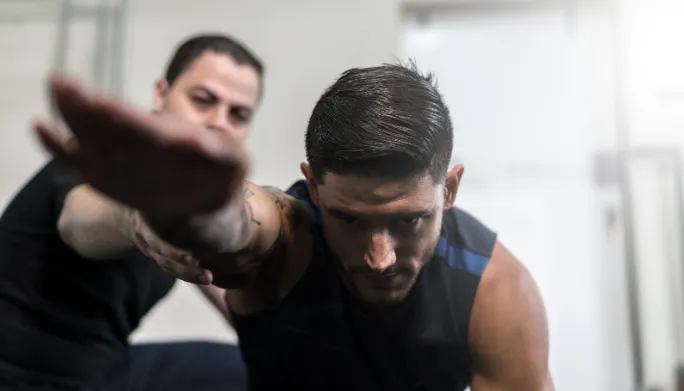In the U.S. alone, 54% of adults over the age of 18 are impacted by musculoskeletal conditions. That’s over half of the America population! What’s even more alarming is that one in three sufferers report that their conditions are debilitating.
Today, we’ll look at common bone and joint issues such as arthritis, back pain, hip pain, and osteoporosis. We’ll also explore effective treatments and simple tips for managing these musculoskeletal conditions.
Ready to kiss pain goodbye and get off the sidelines for good? Let’s get started!
Common Conditions & Causes
Arthritis
An inflammation of the joints, arthritis is one of the most common bone and joint issues. The condition can affect one joint or multiple joints. Although it occurs most commonly in adults over 65, children, teens, and young adults can also suffer from arthritis.
Characterized by pain, swelling, and stiffness in or around the joints, arthritis symptoms are often exacerbated by a sedentary lifestyle, but even laying in bed at night can trigger flare-ups in the morning, with stiffness persisting for several hours after waking.
The two most common forms of arthritis are osteoarthritis (OA) and rheumatoid arthritis (RA). OA is generally caused by repeated motions, normal wear and tear, an injury, or infection. A breakdown of cartilage tissue (the connective tissue that protects your joints by absorbing the shock and stress generated when you move) can also lead to OA.
An autoimmune disorder, RA is another common type of arthritis that occurs when the body’s immune system attacks the body’s tissues. These immune system attacks impact the synovium, a soft tissue in your joints that creates a fluid that lubricates the joints and nourishes the cartilage. The exact cause of RA is disputed, but studies suggest that it may be genetic.
Back Pain
Tightness, pain, and / or a decreased range of motion are all indications that your back needs a tune up. If your back is sore from Delayed Onset Muscle Soreness (DOMS), then the pain is normal and temporary. Typically developing six to eight hours after a particularly demanding workout or race, DOMS will reach its peak within 24 to 48 hours and should then fade away around 72 hours after the workout.
If your back pain is stabbing, sharp, or comes on suddenly, it might be an indication of something more serious. Swollen joints or stiffness when you get up in the morning may be signs that your back pain is not from a muscle strain, but from a condition affecting your joints instead. Arthritis and ankylosing spondylitis are both causes of inflammation that result in back pain. Your doctor may suggest blood tests or X-rays in order to make an accurate diagnosis.
Hip Pain
If you are experiencing pain or tenderness in one or both hips, you’re not alone. And while hip pain can be common, there are a wide variety of causes. Your hip pain may be caused by a tendon or muscle strain, both of which can heal with a little time and some help from your physical therapist.
Other causes of hip pain include arthritis and femoroacetabular impingement (FAI) or hip impingement. FAI is a fancy way of diagnosing an unusually shaped hip joint. This unusual shape can cause friction between the acetabulum (part of the pelvis) and the top of the femur (thighbone).
Trauma such as a fall, collision, bike crash, or other accident can also be the cause of hip pain, particularly if this results in a hip fracture. Occasionally, a health condition that weakens the bones, such as osteoporosis, can cause a hip fracture and consequent pain.
Osteoporosis
Osteoporosis is a disease in which the bone’s quality and density are reduced. A diet consistently lacking in calcium is a top contributing factor to the development of osteoporosis. When osteoporosis occurs, the risk of fracture is increased significantly as bones become more porous and fragile.
But the loss of bone occurs progressively, often undetected. In fact, many osteoporosis cases are not discovered until a bone fracture occurs. On the other hand, this loss of bone may present itself as decreased balance and strength, or back, hip, neck, ankle, and wrist pain.
Effective Treatments & Management
Fortunately, many of these bone and joint conditions respond well to medical treatment and physical therapy. Arthritis is a manageable condition and has been shown to improve with the right exercises, no matter how long you’ve had it.
Walking, hiking, and swimming are all fantastic, low-impact approaches to improving joint health… and your mood too! Yoga, tai chi, pilates and strength training using your body weight also work to restore balance, flexibility, and range of motion, which supporting bone health.
Strength training is also recommended for prevention of arthritis in those who have FAI or other conditions that frequently increase the chance of arthritis. For more targeted exercises, a physical therapist can help provide strength training programs that focus on joint rehab and musculature support.
When it comes to relieving pain in the hip joint, don’t underestimate an ergonomically-correct set up at work and regular mobility exercises. To improve hip mobility and activate your hip flexors, try exercises such as kneeling lunges, internal and external hip rotations, and the “>hip extension exercise. This exercise is not only helpful for arthritis sufferers, but also beneficial to anyone who needs to strengthen the glutes (basically, everyone)!
In the case of back pain, strength training is one of the smartest ways to help musculoskeletal back issues. “From athletes to older patients, strength training is critical for treating back pain,” says Dr. Ryan Godfrey of Change the Game PT.
Strength training and stretching are one of the quickest ways to relieve back pain and prevent a relapse down the road. To help strengthen the muscles around your spine while improving flexibility, try kneeling rotations, side-lying rotations, wall rotations, and foam rolling.

Working with a trainer or physical therapist is key in treating bone and joint related back problems. Your PT can give you a movement screen, use trigger point dry needling to break the pain cycle, and prescribe workouts that target specific muscles.
Strength training is also the best way to combat osteoporosis, as well as improve balance and stability. Strength training exercises may include the use of TRX, free weights, kettlebells, and resistance bands.
Speak with your physical therapist about creating an exercise program customized to your unique needs. And remember that muscle strengthening and flexibility exercises are crucial to bone health and density, even if you’re pain free!
Contact Change the Game
Our bones are living tissue and constantly changing. That’s why it takes a team to manage any of these bone and joint conditions. And your PT is a resource that you can turn to for help in treatment that will get you back to an active lifestyle.
If bone and joint pain is keeping you from enjoying the activities you love and negatively impacting your quality of life, then here’s something you’ll be happy to hear:
You don’t have to miss out on the active life you love anymore! Ready to tackle your pain and get back to moving better and feeling better? Call the team at Change the Game PT and schedule a free discovery visit today!


